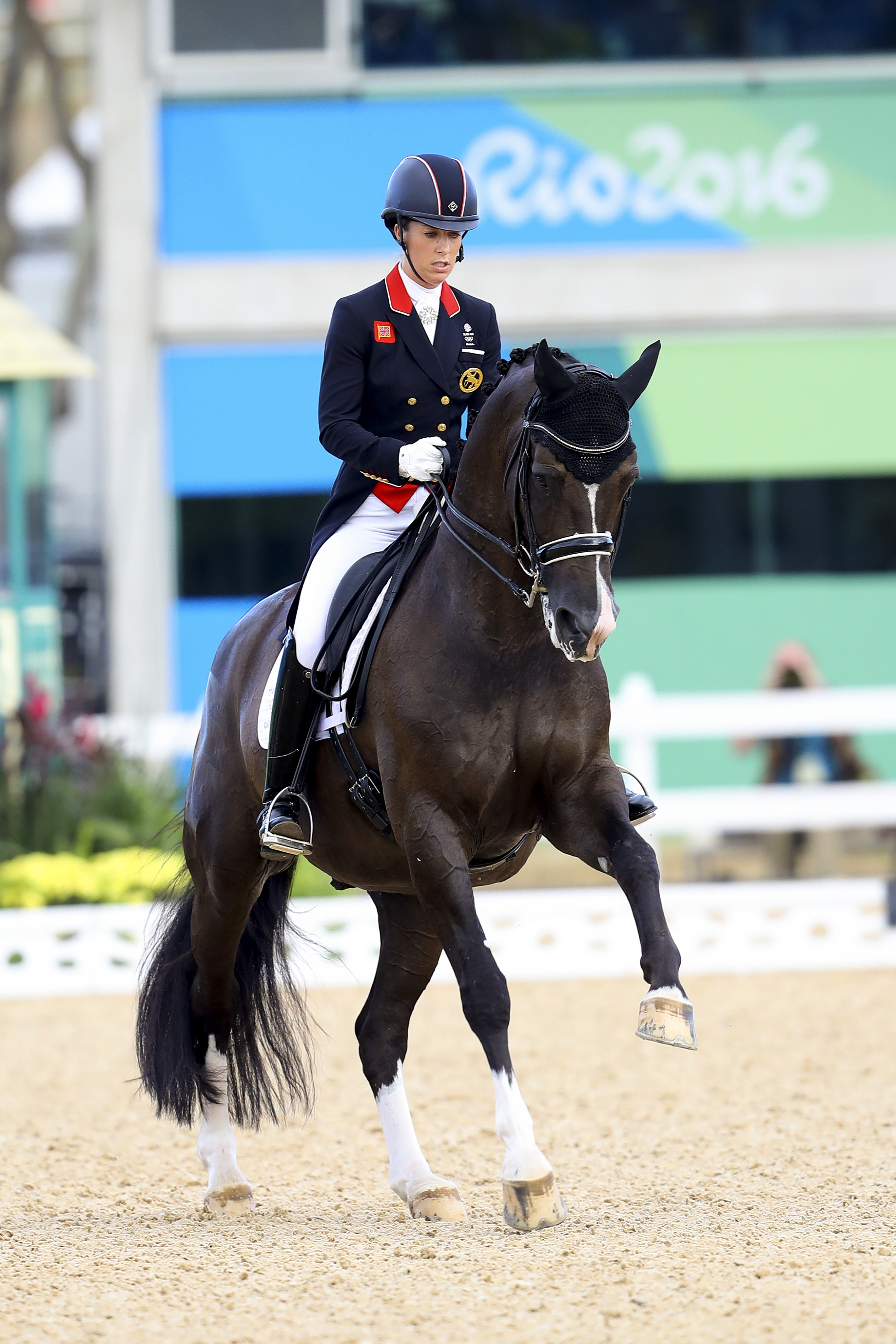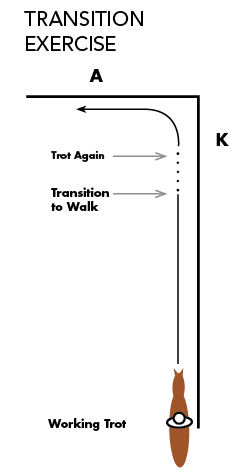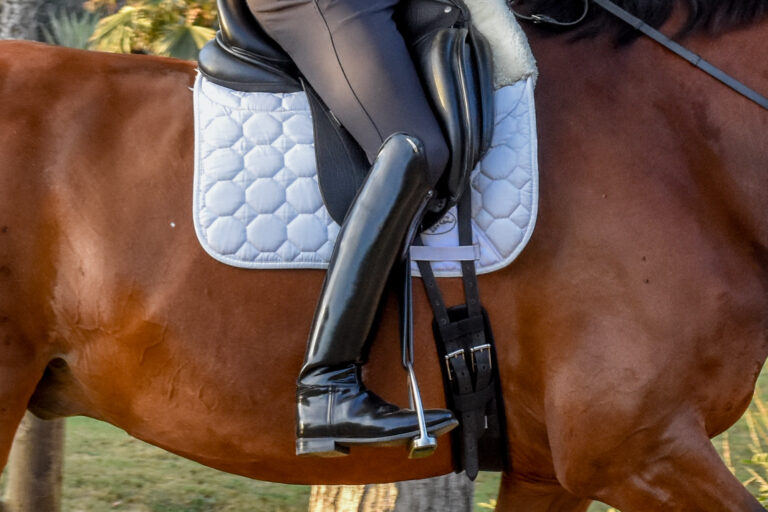To understand what it means to have the horse “in front of the leg,” imagine driving an automatic car. You shift into drive and when your foot is neither on the gas nor the brake the car rolls forward. A horse is in front of the leg when he is thinking forward and traveling forward of his own accord. Some cars are set to a high idle while others have a lower idle. Similarly, some horses are more naturally forward while others need a little more encouragement from the rider.

(Arnd Bronkhorse- Arnd.nl)
In Front of the Leg
When a horse is in front of the leg, he feels as if he is taking the rider somewhere as opposed to the rider making him go somewhere. The rider’s leg is quiet, her seat is supple and swinging with the horse’s back and the horse is pushing from behind into the contact. I know my horse is in front of my leg when I can sit relaxed through my hips, drape my lower legs on his sides and follow his movement without a driving effort. When I apply slight leg pressure, he has an immediate and appropriate reaction. This is important because when you ride a movement, your leg aids can then influence the impulsion, which is the horse’s ability to thrust from behind. Instead of using the leg just to go, when the horse is in front of the leg you have the flexibility to ask him to move more forward, more sideways, more upward or to swing more during the exercise. This allows you to make the gaits and the essence of the movement more elastic and expressive.
The qualities of being through and in front of the rider’s leg go hand in hand. Throughness is when the rider’s commands can influence the horse freely through his body because of an absence of resistance. The horse must have a degree of throughness to maintain a supple topline and allow him to be in front of the leg. If there is resistance in the horse’s body, then he is not through and cannot be in front of the leg. Make sure you can consistently maintain a steady rhythm and tempo (note that being in front of the leg does not mean going as fast as possible), suppleness and relaxation. Then the horse is soft and elastic with a connection from back to front and he can be responsive to subtle suggestions from the rider.
Rider Prerequisites
Rider position is key to putting the horse in front of the leg. You must be in a position where your ear, shoulder, hip and heel are all aligned vertically. The rider’s seat should be supple and relaxed with legs draped just behind the girth.
To get the horse in front of your leg, use a systematic approach with your driving aids and be consistent—ask with the same aid for the same response every time. Keep your seat loose when you use the leg. I say, “release your hip” because this gives my students a good visual. Now, let’s use the aid for walk to trot as an example. Begin in the medium walk.
• Apply pressure with the upper calf area of both legs momentarily.
• Immediately release and soften the pressure. The horse should make a transition to trot right away.
• If the horse did not respond, make a correction immediately by giving a stronger aid with the leg.
• If the horse has still not responded, use a tap with the whip.
• When the horse has trotted off nicely, praise him.
Every time you use your leg for an aid, repeat these steps in this order and praise your horse when he gives you a response. If he needs a correction, be sure to repeat the transition again and see if you can do it without a correction. Train him to need fewer, smaller corrections and therefore more invisible aids. Then he will feel more eager to respond to the aids.
Clashing aids is a common problem that prevents the horse from responding to the aids. Every rider must learn to have an independent seat, leg and hand to have a horse happily in front of her aids. If the horse feels “go” with your legs and “stop” with your seat or hands, he cannot react to the aids and come in front of the leg and seat. Seat lessons on the longe line can help riders learn this skill.
Another problem I see is tightness in the seat, knee and thigh. Riding without stirrups works wonders for a tight seat. Learn to let gravity pull you into the back of the horse in all three gaits. As dressage riders, we must learn to call on our abdomen and lower back muscles instead of just our adductor muscles in our inner thighs. Over time, our seats develop as we strengthen the muscles such as the psoas major, the iliacus and the piriformis muscles. When these muscles are free of negative tension, our bodies move more freely and our horses move with more ease. Then the horse can be in front of the leg aids.
Try This

Incorporate a transition from working trot to one stride of walk then immediately up to trot before you ride through each corner in the arena. This exercise helps get the horse in front of your leg because the quick transitions activate the hind legs and create reactivity in the horse. At the same time, the bend in the corner keeps him supple.
As you approach the corner, be sure your horse is flexed slightly to the inside. About 25 feet from the corner, execute a downward transition to walk by closing your legs, pushing your belt buckle slightly forward, dropping your pelvic floor or “sitting deep,” and squeezing your fingers enough that he responds into the walk.
As he walks on the straight line, use your leg aids as described above to do a transition to trot before the corner. Immediately, you will be trotting through the corner. Ask for the inside bend from your inner leg at the girth.
To ride only one stride of walk from the trot takes a lot of practice, so allow yourself a few tries to get the timing of the aids down. If you get more than one walk stride, ask for the trot sooner or with a bit more gusto. Contrarily, be sure you get the full walk stride and not just a jig step. When the horse pushes off to trot from only one stride of walk, he does so in an uphill, forward way because you’ve asked for the upward transition before he has the chance to redistribute his weight to his forehand from the transition.
Now you have the feeling that your horse is in drive. Always monitor the horse’s throughness and your balanced position and you can ride your horse in front of the leg.
Ana Gilmour is a USDF Certified Instructor through Fourth Level and an ‘L’ Education Program Graduate with distinction. After apprenticing with Hilda Gurney for seven years in Moorpark, California, she spent time training in Europe, Asia and the Middle East as well as training and competing in Wellington, Florida, for several years. She is now based out of Northern California. She is also an accomplished musician and designs musical freestyles at all levels.











